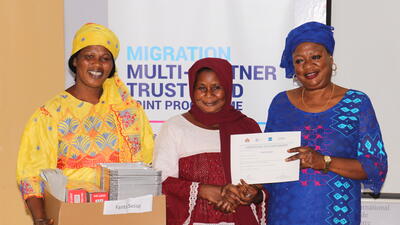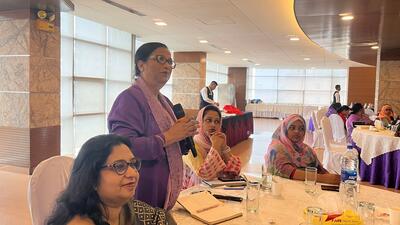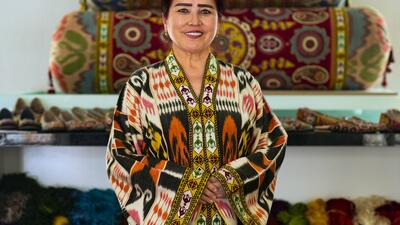Women entrepreneurship: A force for growth
Data from the most recent Global Entrepreneurship Monitor (GEM) suggest that women represent approximately one third of all new business activity and one fourth of established business activity in countries around the globe. These data represent an important step in measuring women’s contribution to global development. Advocates for women’s rights have long recognized that women are a powerful force in economic and social development. Women are also the largest consumer group in most countries and are compassionate consumers who focus on core economic and social services, as evidenced by the experience of microfinance and development organizations. These observations have led to a new understanding of the importance of investing in women’s economic participation in developing and advanced economies.
Because women participate extensively in the informal sector, they are generally underrepresented in business registration and employment data. Many women informal workers engage in business activities, but focus on work that is associated with family responsibilities and local community development. Even in the most advanced economies where large numbers of women start and build formal businesses, women are often silent partners in business ventures, especially as minority owners of family businesses, and are less likely to register their business than men. In some countries, the work that women do, though it may generate substantial income, is neither reported nor even identified as work.
The most comprehensive source of data on new business activity around the world is found in the annual population survey conducted by the GEM research programme (www.gemconsortium.org). Each year, national GEM teams interview some 150,000 individuals in over 50 countries to better understand the perceptions, prevalence and types of entrepreneurial activity driving national growth. Women entrepreneurship is one of the key measures of the GEM survey. GEM estimates for each country the number of adult men and women (age 18–64) starting a new firm or currently owning or managing a firm which is less than three years old. Entrepreneurial prevalence among adult populations varies tremendously, with the highest rates generally found in early to middle stage developing economies. The lowest rates of women participation are found in conservative Islamic countries, where as much as 70% of the unemployed are women, and in some Asian and European countries where men entrepreneurial participation rates are also extremely low. The highest rates of women entrepreneurial activity are found in countries such as Thailand and China, which have rapidly growing economies and strong traditions of women labour participation.
While the entrepreneurial gender gap varies considerably across countries and within each level of development, the overall gender pattern remains fairly consistent from year to year. Not surprisingly, the biggest gaps are found in conservative Islamic countries and in some advanced economies where women are drawn to jobs with strong family support benefits, including childcare services, generous family leave and part-time or flexible work schedules. The smallest entrepreneurial gender gaps are found in Asian countries with high rates of women labour force participation and in countries with the lowest levels of entrepreneurial activity, namely Japan and the Republic of Korea.
Several GEM studies have investigated the broad variation in rates of men-women economic participation from country to country. Some attribute the variation to structural factors such as unemployment, national wealth, economic growth and economic freedom. However, there are still systemic variations within the three categories of economic development (factor-driven, efficiency-driven and innovation-driven) as shown in the figure, suggesting that economic factors do not fully explain the observed gender patterns. Multilevel, cross-national research studies using the GEM data suggest that factors such as the rate of women business leadership, gender wage inequality and public expenditures on childcare influence women’s decision to start a business.
Barriers to entrepreneurship and business ownership for women include access to capital, access to education and training, freedom to work and travel, access to mentors and cultural ideals of strong women business, and political leadership. Discriminatory processes vary in character and effect across countries. For example, in some developing economies, women face serious barriers to capital when property rights are limited or established business processes include women-specific requirements, such as men co-signatories on loans. The extent to which family arrangements and religious beliefs restrict women’s freedom to work and travel also vary across countries. The political imperative in these countries is clear. Women require equal rights and freedoms to conduct business if they are to succeed in business.
In advanced economies, the barriers to business success for women are more subtle and harder to measure. Gender differences in access to capital, for example, are still apparent. However, those differences are explained largely by the size, age or industry of the business and by the education and experience of the owner. Scholars are focusing on the fine line between discrimination and self-selection. Discriminatory factors may include less favourable expectations of competence for women in business and the impact of communication differences in establishing trust and credibility in investment pitches. Self-selection factors include preferences for different lifestyles and industries, and lower levels of confidence or self-efficacy in the context of entrepreneurship and self-employment.
One analysis in the 2008 GEM Women’s Report found that as much as 30% of the gender variation in economic participation between countries is explained by factors related to environment and access to resources. Certainly policymakers need to consider the opportunities as well as the proportion of the population capable of starting and succeeding in businesses. In terms of skills and resources, women in many countries are not in the best position to start a business. Women entrepreneurs tend to be more educated than men entrepreneurs, to start businesses in different industries (most often in highly competitive service industries), to report lower growth expectations but deliver similar levels of innovation, and are more likely to report non-economic goals driving the venture.
For women, however, the most significant factors predicting new business activity are perceptions of the self and the environment, including confidence, expectation of opportunities and fear of failure. Women appear to share similar views of the environment, but tend to have lower levels of confidence and appear more susceptible to fear of failure, especially in developed economies. These disadvantageous perceptions among women are offset by higher levels of education, age and business/financial experience, especially in more advanced economies.
Recent GEM findings also suggest that men and women pursue different goals in business. Compared to women, men entrepreneurs are more likely to focus solely on making a profit, while women entrepreneurs are more likely to emphasize social goals and values. These GEM findings are consistent with qualitative studies and theories of women’s entrepreneurship that find women tend to hold lower growth expectations and tend to grow smaller businesses. The implications of these gender theories and findings are that while women focus on producing a high-value return to customers, they may focus less on market reach, competition and business valuation compared to men. These different approaches or perspectives to entrepreneurial activity are not necessarily a disadvantage for women or the economy, but rather drivers of different patterns of economic participation and business growth.
Different goals, access to resources, family responsibilities and business credibility combined with the available opportunities lead to a particular characterization of women entrepreneurship. Research based on a variety of data sources, including GEM, demonstrates the vital nature of women’s contribution through the development of hardy ecosystems with strong community-based foundations to support economic growth and prosperity. Despite the barriers, women still manage to make a significant and essential contribution to sustainable social and economic development through business creation. Women’s efforts lead to significant advances in education, health care, and food services and increasingly in the area of high technology as women pursue education in the sciences, mathematics and technology.
It is up to government and community leaders to set a clear agenda supporting education and opportunities for women entrepreneurs and to recognize that an investment in women as entrepreneurs and leaders will pay dividends. While research and policy discussions have a tendency to suggest that investing in women’s advancement is a zero-sum proposition, this is not the case. In fact, most entrepreneurial activities involve women and men working together to meet the needs of the market and the community. Investing in women entrepreneurs ensures a stronger basis for economic growth as this investment will be felt across the community, resulting in a stronger business ecosystem.















